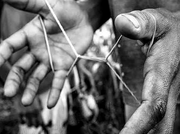Alongside Rover Thomas, Emily Kngwarreye was a seminal figure in contemporary Aboriginal art, developing a unique range of working method and establishing a visibility for Aboriginal art that ensured its success for coming generations. Belonging to the Eastern Anmatyere, Kngwarreye was born in Utopia, north east of Alice Springs. Like the settlement of Papunya, by the late 1970s Utopia had developed a vital indigenous arts practice and during this period, Kngwarreye co-founded the women’s batik-making project and began to paint.
Read MoreBy the late 1980s she was recognised for her signature ‘dump-dump’ dot paintings. Drawing from traditional body-painting designs her work featured interconnected lines beneath luminous patterns of dots. Kngwarreye’s inventiveness as a painter and her extraordinary colour range has been compared with the work of Monet and Abstract Expressionist painters. However, the iconography of her painting was drawn from her homeland of Alhalker, revealing the cycles of nature and spiritual forces of the desert country.
Kngwarreye posthumously represented Australia at the Venice Biennale in 1997. Her work is held in the collection of the National Gallery of Australia, Canberra and the National Gallery of Victoria, Melbourne.




